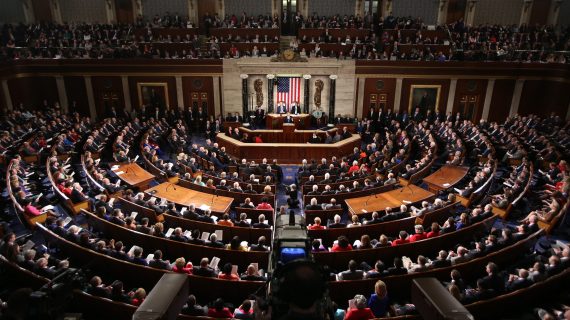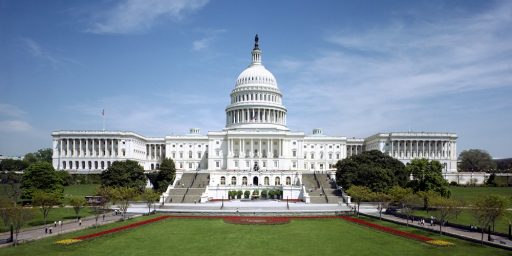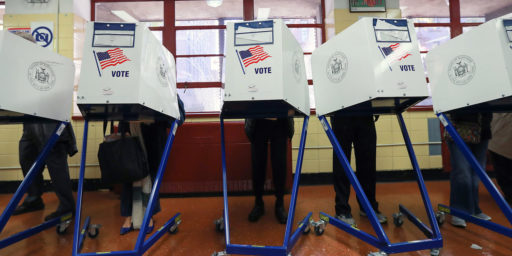Do We Need A Bigger House Of Representatives?
Would increasing the size of the House of Representatives be the cure for what ails Congress?
Brian Frederick asserts that the cure for what ails Congress is, well, a bigger Congress:
The American public’s dislike of Congress is far from a new development in US politics. However, over the past few years the situation has gotten even worse with public approval of this institution hovering around historic lows.
The vast majority of citizens in this country think most members of Congress have lost touch with the people and don’t represent their interests. There are not many simple answers to remedy this problem but one change that might help bring members of Congress closer to the people is to increase the size of the US House of Representatives to 680 members.
One hundred years at 435 seats
For almost a century the House has consisted of 435 members. This seemingly permanent fixture of American politics often obscures the reality that during the first century of the country’s existence the House was increased almost every ten years after its original size of 65 members was established.
The idea of increasing the size of the House of Representatives in light of the increased population of the United States isn’t a new one. Both James Joyner or and Steven Taylor wrote about similar proposals some four years ago, as have conservative columnists such as Jeff Jacoby, and in 2009, there was even a lawsuit filed by a very conservative group that primarily concerns itself with the school choice and homeschooling movements arguing that the 435 person limit was unconstitutional. Going back even further than that, the issue of a mechanism that allowed Congress to grow as the population of the country grew was something that the drafters of the Constitution and Bill of Rights actively considered at the time of the very beginning of the Republic. When the Bill of Rights was submitted to the states for ratification, for example, the very first Amendment was one that set out a formula to allow the House of Representatives to expand its size as the nation grew:
After the first enumeration required by the first article of the Constitution, there shall be one Representative for every thirty thousand, until the number shall amount to one hundred, after which the proportion shall be so regulated by Congress, that there shall be not less than one hundred Representatives, nor less than one Representative for every forty thousand persons, until the number of Representatives shall amount to two hundred; after which the proportion shall be so regulated by Congress, that there shall not be less than two hundred Representatives, nor more than one Representative for every fifty thousand persons.
Because it did not receive enough support, this proposed amendment was never ratified. Had it been passed, though, it would have required that the size of Congress be adjusted with every Decennial Census and the House of Representatives today would have as many as 6,000 members, one for every 50,000 Americans. After the House reached 200 members, of course, Congress would not have been required to make continual adjustments that were exactly in line with the formula set forth in the Amendment, of course, but it is at least conceivable that with such guidance from the Founder there would have been more care taken toward keeping both the population of individual Congressional Districts at a reasonable level and keeping the House itself at a reasonable level given those guidelines. After all, a Congress made up of 6,000 people would be unreasonable and probably would function worse than what we have now just due to the plethora of voices. However, a larger Congress where individual members had a smaller number of constituents than they do today likely would have resulted, and that would have made the House more representative, and probably more competitive than it is today.
For his part, Frederick suggests a House of Representatives made up of 680 members, just a little more than 50% bigger than it is today:
Why specifically do I support 680 seats as the appropriate size of the House?
The freezing of the number of seats in the House at 435 came about in a somewhat arbitrary manner. In most advanced democracies, the number of seats in the lower house of national legislatures happens to approximate a number that is the cube root of the nation’s population. (The cube root of a number is a value that, when used in a multiplication three times, gives that number. For example, 27= 3x3x3 so the cube root of 27 is 3.) This is an observation, by the way, that was first made in a report on the British elections of 1909.
If we apply this “cube root law,” as it’s called by political scientists, to the current American population of 315,000,000 then it mandates that the US House ought to have a membership of 680 representatives.
There is a rationale that underpins this empirical regularity in other democracies’ legislatures. All legislative bodies must balance the need to operate efficiently while providing effective representation to the citizens in their districts. Legislators need to communicate with their fellow members. They also need to stay in touch with their constituents. The cube root law allows the number of seats to reflect an increase in the country’s population but on a proportional or graduated scale.
Legislatures are not designed to expand in direct proportion to the population because to do so would undermine the capacity to legislate effectively. However, if the average number of constituents in a district becomes too large, the legislator will be unable to communicate effectively with constituents.
The US House has clearly reached the point that the channels of communication between representatives and their constituents have been hindered by the 435 seat limit.
Increasing the size of the of the House to account for population growth in line with the cube root law of national assembly size is far from the only solution for remedying the lack of responsiveness of House members to their constituents, but it would certainly make a contribution toward bridging the divide that presently exists. If the average House district population size continues to expand, the prospect for greater divergence between constituency preferences and policy responsiveness will only be heightened.
A House of Representatives of 680 members would make the House of Representatives thirty seats larger than the British House of Commons, which has 650 members representing a population of some 64.1 million for an average constituency size of roughly 98,000 people. A House that matched this ratio would have over 3,000 members, which is obviously impractical, of course. By way of another comparison, the Indian Parliament has 795 members divided among a population of more than 1.2 billion people for an average constituency size of more than 1.5 million, which is larger than the roughly 700,000 people we have now and seems to be far too large a constituency for a nation such as ours. By contrast, a House of Representatives with 680 members would have an average District population of roughly 460,000 people. That’s certainly larger than the numbers that the apportionment Amendment proposed in 1791 would have allowed, but it’s certainly better than where things are now and allows for Members to be more responsive to their constituents because there are fewer of them to respond to, and for individual constituents in larger population districts to have a greater say in who represents them. After all, under our current system the ~580,000 residents of Wyoming have a greater say in the selection of their Member of Congress, and their two Senators, than, to pick an example of the ~750,000 people who make up the 13th Congressional District in New York currently represented by Charles Rangel, who has been serving in Congress for the last 43 years during which he has had only a handful of re-election bids that can be called truly competitive even after he was censured by the House for violating tax laws and House ethics rules.
We don’t have to wed ourselves to Frederick’s idea of a 680 member House, of course. The number could be somewhat smaller, or somewhat larger. As a practical matter, I would think that the upper limit ought to be somewhere around where he recommends, however. A House of Representatives of 700 or 800 members, or more, would seem to be impractical to say that least. As it is, debates on legislation on the House floor only allow individual members to speak for short periods of time, and don’t really constitute “debates” in the sense that a normal person might consider them but of each party setting forth its position for the record and, of course, members getting themselves screen time on C-Span that can be seen on local television back home, or maybe even the national news. A House that is twice as large as it is today would mean longer periods for debate and that it would take more time for even the simplest legislation to get voted on and sent to the Senate if it passes. Additionally, there’s the simply matter of physical space, both on the House floor itself and office space around Capitol Hill.
Some of the physical space problems that a larger Congress would create could be alleviated if we adopted some of the suggestions that have been made in the years since the September 11th attacks for a Congress that is more disbursed, with meeting locations around the country that are connected via video feeds and other technology. That solution, however, brings up one downside to a bigger Congress that Frederick seems to ignore. One observation that political pundits and former Members of Congress have made in recent years is that Congress is far less collegial than it used to be, in no small part because Members don’t interact with each other across party lines as much as they used to. Today, instead of sticking around Washington on weekends when the House is in session, Members are likely to be seen rushing to National Airport to catch a plane home for the weekend. A larger House would mean even more likelihood that, say, the Republican from Alabama’s 2nd District won’t even know who the Democratic from California’s 32nd District is, never mind what they look like, unless they happen to serve on the same committee together, and even then committee sizes will be larger and their functionality will be impacted as well. Over time, perhaps, that will change if enlarging Congress means that both sides much become less ideologically rigid, but it’s a factor worth considering if we’re ever going to do something such as this.
As Frederick notes, the likelihood that we’ll see this kind of reform any time soon is unlikely. It wouldn’t require a Constitutional Amendment, but it would require both Houses of Congress and the President to agree on the changes. Since these changes will have the potential to reduce the effective political power of both political parties, that’s not necessarily likely. Additionally, given current public attitudes about Congress it’s not going to be easy to convince the average American that the solution to their problem is more Members of Congress. That being said, this is an idea is a reform that is worth considering, especially if its combined with other more fundamental reforms such as multi-member districts, which would required a Constitutional Amendment, and Instant Runoff Voting, which is something that could be implemented at the state level without Congressional assent at all. At the very least, it’s hard to see how such a world could be any more dysfunctional than what we have today.







What the hell has been going on in the Hoosier State?!
LOL! Fixed
I’ve got a wild idea. What say we divide the country into, say, 50 different areas and each of those areas could have their own much more representative legislatures. Then we limit the activities of the federal government to a military for the entire country, foreign policy, and regulation of the actual interactions between the 50 distinct areas.
The cube root strategy ignores something important: the complete and obvious impossibility of any legislator providing adequate representation for a constituency of a half million. We either want representative democracy or we don’t. Either we reduce the sizes of the constituencies represented to something truly representative or we abandon the present travesty on representative democracy entirely. How much more representative is a legislator serving a constituency of a half million than one serving a constituency of 10 million? I would submit not much. That a constituency of 315 million?
Be it 680 or 800, a House that large would require an increase in support staff, new buildings and, of course, an increase in all the agency staff to deal with all the new members and so on until the federal government is twice as bloated and ineffective as it is today.
We could solve the space issues by requiring all members to be under the age of 12, and replacing all of the adult sized desks with children’s desks. This would also end up instituting term limits.
I don’t think it would change the character of the House much though.
Hell, no!
(And I didn’t read the post.)
All of this is moot if your representative continues not to represent you. The recent article about phony populism was good for showing that by and large your representative is unlikely to be like you. Members of Congress are usually much much much wealthier than they people they represent. They spend a majority of their time soliciting money for reelection and or kowtowing to their wealthy backers. When they leave congress they tend to be even wealthier, whether they go lobby or not. As long as all of our representatives continue to come from the wealthiest among us and represent the interests of the wealthiest among us, it won’t be representative. How long did the congressional ban on insider trading last? A few months before it passed a 10 second vote in the House and 14 sec vote in the Senate to repeal it. It is a far cry from the citizen farmer doing a service to the nation and representing people like themselves.
Honestly, right now we have about 200 Members of the House who are not interested in good governance, so what would be gained by increasing the number of malevolent representatives to 300-350?
I’m not at all convinced that our problems in representative government are due to the algebra of representation based on 435 Members in The House. Our problems are related to the quality of the people we elect and the voters who elect these representatives.
@Dave Schuler: One of the big reasons we are more “advanced” than chimpanzees is our ability to form larger cohesive social groups. Chimps can form social groups of roughly 50 individuals that they know well enough to trust implicitly. Chimps outside this 50 are treated as strangers, with all the accords that come with that. Our social group size is something closer to 150, give or take about 50.
So any representative democracy that has a constituency size above that mean is already, as you phrase it, a travesty. Quibbling over the numbers with that rationale is pointless. This is less about individuals represented than communities, and a larger amount of representatives each vying for territory makes it harder for state authorities to carve districts into ridiculous shapes for political gain.
@al-Ameda:
So the problem with democracy is democracy then? 🙂
@Tillman:
Well, good quality is certainly not constant, it goes up and down over time. I’m just saying that changing the algebra – that currently leads us to 435 representatives, to one that gives us around 700 representatives – is not necessarily going to result in less dysfunction or less malevolence.
Sort of a ‘rearranging the deck chairs on the Titanic’ problem. 😀
Do we need a larger House or one less controlled by self interest and more controlled by intelligence and the real needs of the country rather than the demands of the wealthy donor?
We are entirely focused on the money in the coffers rather than what is needed for us to have a real Democracy.
Glad to flag the fact that 435 is the product of a statue — and that up until 1920, the size of the House had changed every decade.
Similarly, single-winner districts are the product of statutes, not in the Constitution. Before the first congressional mandate to use single winner district s in 1842, states regularly used multi-winner districts. That mandate came and went in the years since, most recently reimposed in 1967. For the case for a new mandate for fair representation voting methods in multi-winner districts, visit the nifty interactive map with analyses at http://www.FairVoting.us
@Dave Schuler: Indeed. A radical idea, to be sure, but last time it was tried, it worked pretty well for almost 200 years until replaced by the current system.
Does make sense, though, if you think on it… reciprocity.
@Tillman: Social groups.
Not government groups.is a difference, which tends to explain rather well why big government doesnt work.
While I think it’s a good idea, by itself it will just make the current mess a bigger mess. Other things would work better- an end to gerrymandering or cumulative voting, maybe. Hell, I’d settle for a media that does its job by defending truth and calling out lying politicians, but I guess even that sounds fantastical. Maybe we should give benevolent despotism another shot.
And yes, I’m sounding a little bitter and depressed this morning contemplating the 2014 elections.
@Eric Florack: Your math is a little off. It “worked” pretty well for only 72 years.
A couple of minor points: First that the British House of Commons will only seat 427 of the roughly 650 Members (the number varies year to year). When Westminster was destroyed in ’41, Churchill made sure that that strange arrangement (at least to Americans’ eyes) was continued when the chamber was reconstructed. Don’t ask me to remember his exact explanation but he felt it necessary for the traditional working of their Parliament.
Second, that Ed Milibrand (leader of the Labour Party) is going to propose that the House of Lords be replaced by an American style ‘Senate’ (as reported in todays NYT).
Seems like most of the great democracies are struggling to fit their political systems to the 21st Century and not making good progress.
I think making congress larger would help make it more representative but I’m not convinced this is the problem with congress.
I think one huge problem with congress is that we have career congress members. A group of people who get elected, go to Washington and stay their do the point they become more beltway than home state and become much more obsessed with keeping their position than representing constituencies.
And while the Feds can’t term limit congress members the Feds could.stop providing pensions. Congress members should get paid while they serve but once they’re done they’re done collecting money from the taxpayers.
But career politicans become about one thing-protecting their careers and this IMO is a problem.
@Eric Florack:
Meaning downsize the military, because it too is part of the gov’t, right? Same for police and fire departments.
Everyone wants big gov’t, they just disagree on which parts should be big.
If china can protect itself for $175 billion per year, Exceptional America should be able to do it even better and cheaper, certainly not $700 billion a year. Cut the pentagon budget by 400 billion and every other problem we have would go away pretty rapidly.
@OzarkHillbilly: Weak federation with strong state government? Existed here for about 23 years, but it really didn’t “work” well for any of that time. That’s why we replaced that failed government structure with the Constitution.
Strict constitutionalists like Florack I’m sure long for the good ol’ days of 3/5. I, on the other hand, believe that change is necessary to keep ourselves on top.
If the “original First Amendment” had been ratified, the House of Representatives could still be the size that it actually is today. The final clause of the amendment, which is what would apply now, says, “…. there shall not be less than two hundred Representatives, nor more than one Representative for every fifty thousand persons.” Well, the current House has more than 200 representatives, and it has much less than one representative for every 50,000 persons, so it meets the criteria under the amendment.
If instead the amendment had said “… nor less than one Representative for every fifty thousand persons,” then we’d need a 6,000+ member House.
I think the following quotation from the Federalist Papers (James Madison) No. 55. is very important:
I realize that the idea of putting more politicians on the public payroll annoys a lot of folks, and I am sensitive to Madison’s admonition above.
But I also see some merit to having smaller Congressional districts. Although, I would be scarred to push the size of the House much beyond 500.
In that spirit I propose that the size of the House should be increased to 450 after the next decennial census in 2020, 475 after 2030, and 500 after 2040.
By then I will be dead, but our grandchildren will be able to evaluate the success or failure of the experiment. Personally, I expect that nothing much will differ. But, life can be very strange.